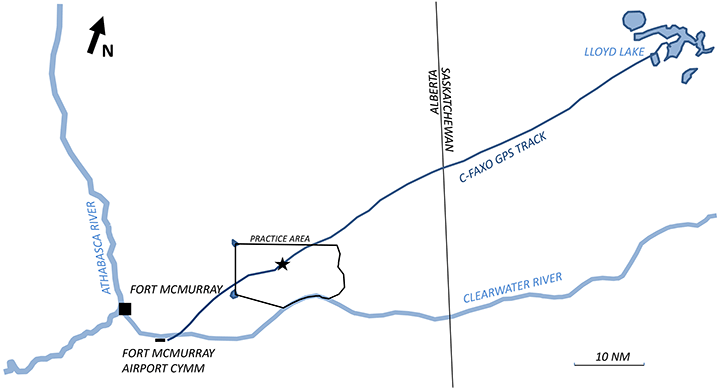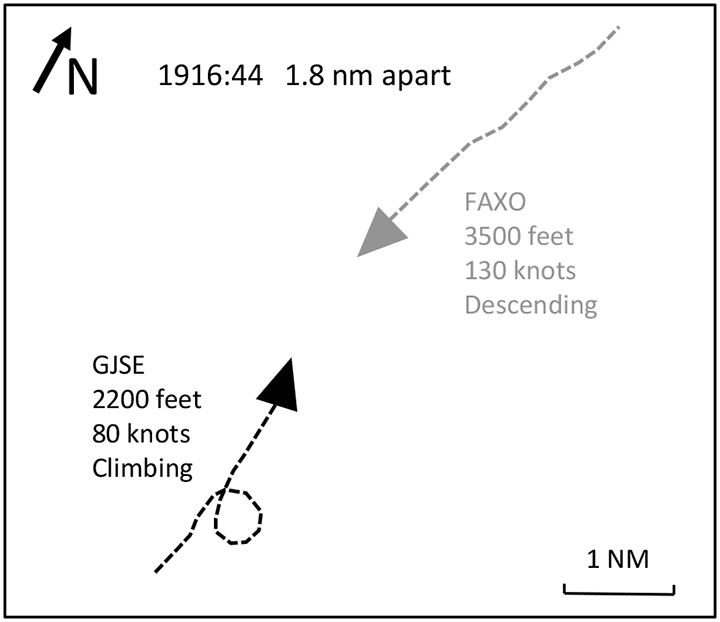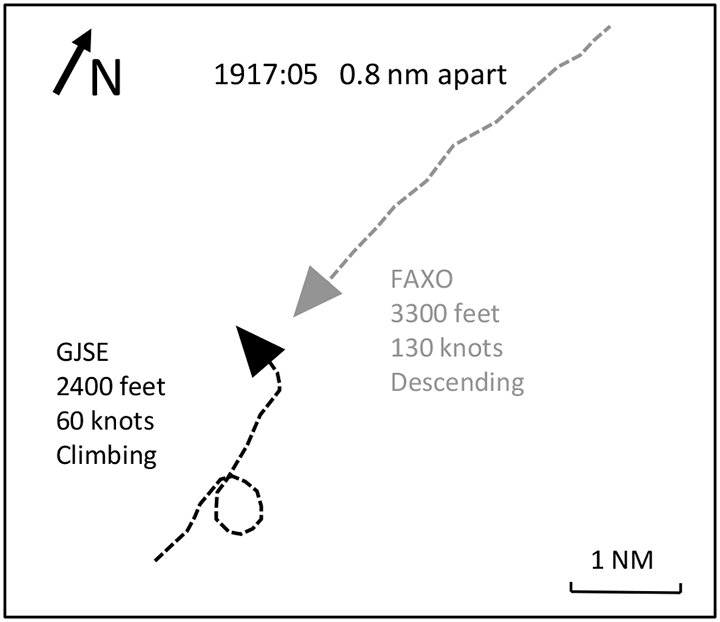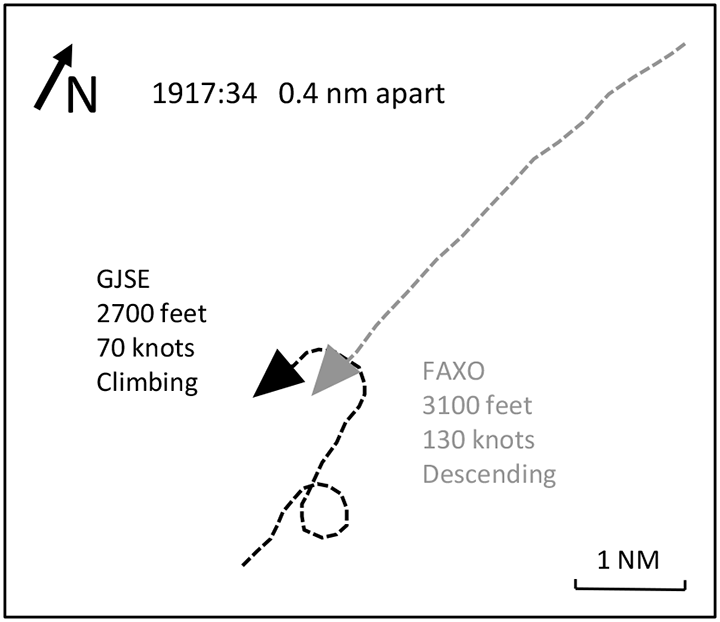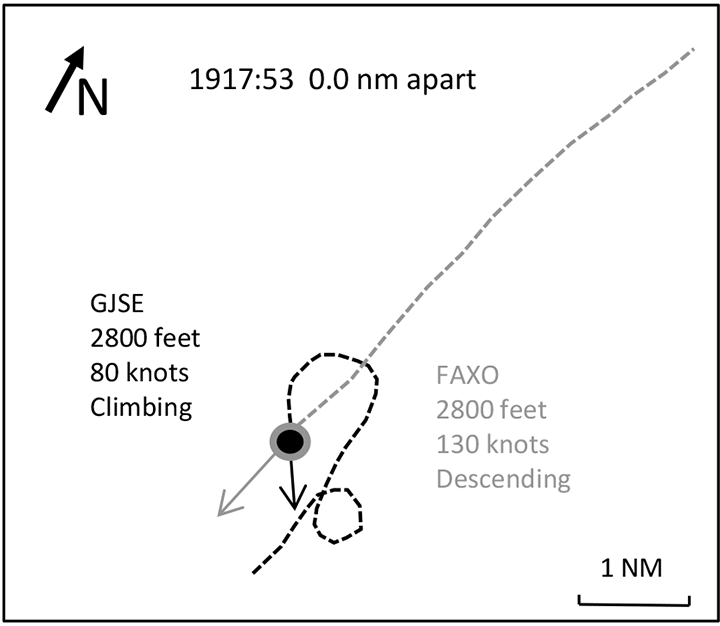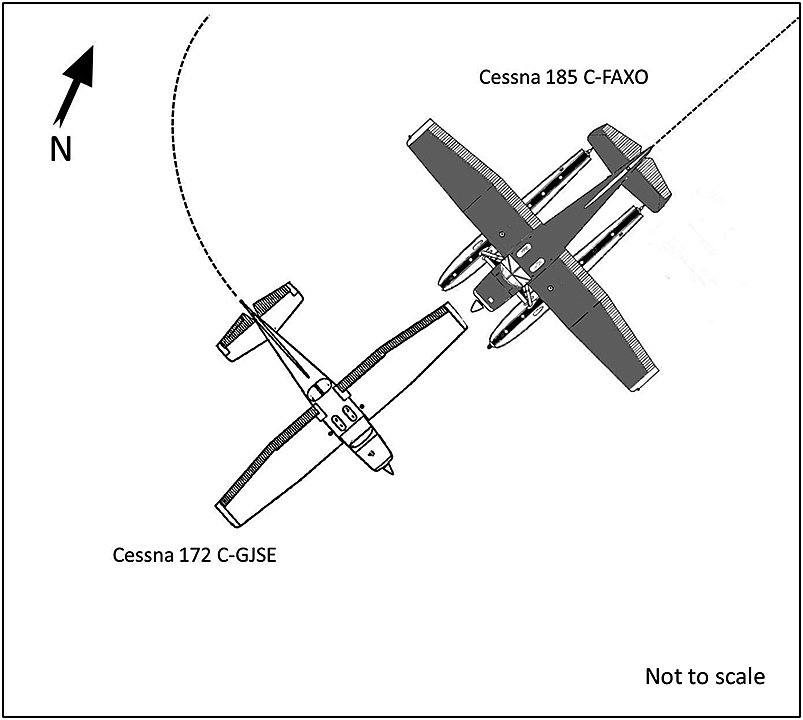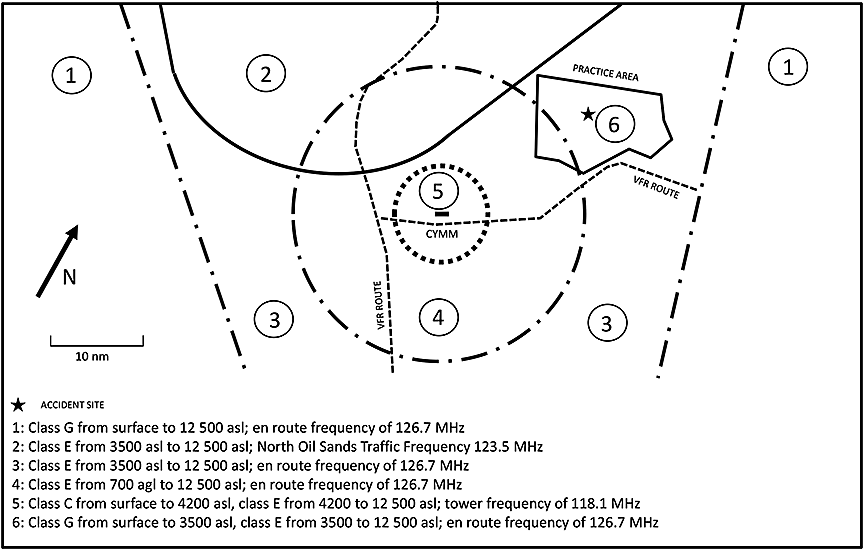Mid-air collision
between
W.M.K. Holdings Ltd. (dba McMurray Aviation), Cessna 172P, C-GJSE
and
Cessna A185E, C-FAXO
Fort McMurray, Alberta, 21 nm NE
The Transportation Safety Board of Canada (TSB) investigated this occurrence for the purpose of advancing transportation safety. It is not the function of the Board to assign fault or determine civil or criminal liability. This report is not created for use in the context of legal, disciplinary or other proceedings. See Ownership and use of content. Masculine pronouns and position titles may be used to signify all genders to comply with the Canadian Transportation Accident Investigation and Safety Board Act (S.C. 1989, c. 3).
Summary
The W.M.K. Holdings Ltd. (hereafter called McMurray Aviation) Cessna 172P (registration C-GJSE, serial number 17274696) was conducting a day visual flight rules instructional flight in the practice area northeast of the Fort McMurray, Alberta (CYMM) Airport. A privately operated Cessna A185E (registration C-FAXO, serial number 18501737), equipped with amphibious floats, was inbound to CYMM on a flight plan from Lloyd Lake, Saskatchewan. At 1917 Mountain Daylight Time, approximately 21 nautical miles northeast of CYMM, the 2 aircraft collided at 2800 feet above sea level (1300 feet above ground level). The collision separated the left float from C-FAXO and displaced the right float, which remained attached. The pilot, who was the lone occupant of C-FAXO, was able to land at CYMM. C-FAXO was substantially damaged, but the pilot was uninjured. C-GJSE broke up in flight; the student and instructor were fatally injured.
This report is also available in English.
Factual information
The instructor assigned to C-GJSE (GJSE) arrived at the airport the morning of 21 June 2015 to learn that his student, scheduled for an 0800Footnote 1 training flight, had postponed the flight until 1800. During the day, the instructor conducted 2 other visual flight rules (VFR) flights. Each VFR flight was approximately 1 hour in length.
The student originally scheduled for the 0800 flight arrived at W.M.K. Holdings Ltd. (hereafter called McMurray Aviation) late in the afternoon and, by 1841, GJSE departed CYMM. The lesson plan for the flight was climbing and descending turns with the student in the left seat and the instructor pilot in the right seat. Ten minutes after departure, the aircraft entered the southwest corner of the practice area. The practice area is located 21 nautical miles (nm) northeast of CYMM in uncontrolled airspace (Figure 1). The training flight continued uneventfully for the next 26 minutes.
C-FAXO (FAXO) departed Lloyd Lake, Saskatchewan, with only the pilot on board at 1843. Once airborne, FAXO proceeded direct to CYMM, climbing to an altitude of 4400 feet above sea level (asl). A direct route from Lloyd Lake to CYMM is approximately 82 nm. At 1849:11, FAXO appeared on radar 77 nm northeast (045°) from CYMM, climbing through 3600 feet asl with a ground speed of 130 knots. At 1915:21, FAXO entered the northeast corner of the practice area, descending out of 4000 feet asl (Figure 1).
At 1916:44, GJSE was 1.8 nm from FAXO, climbing through 2200 feet asl at 80 knots (Figure 2). At 1917:05, GJSE turned left and crossed in front of FAXO at a distance of 0.8 nm. At 1917:34, FAXO made contact with CYMM tower, and was assigned a transponder code. At the time of that communication, GJSE momentarily paralleled FAXO's track in a southwesterly direction, as the aircraft continued in a gradual left-hand turn. FAXO's ground speed was greater, and the aircraft was overtaking GJSE. At 1917:42, the CYMM tower controller advised the pilot of FAXO that there was a Cessna 172 in the area. At 1917:53, the 2 aircraft collided. GJSE broke up in flight due to collision forces and fell to the ground. Both of GJSE's occupants were fatally injured.
The floats were dislodged from FAXO, with the left float separating completely. The right float remained attached but folded against the fuselage. At 1918:34, the pilot of FAXO advised the CYMM tower controller of the collision. The pilot of FAXO was able to maintain 80 knots, and made a plan to land on the grass infield at CYMM. The CYMM tower controller mobilized aircraft rescue and fire-fighting (ARFF), which was standing by when FAXO arrived. The aircraft landed on the grass to the north of Runway 25 at the east end. The aircraft was set down on its belly, which resulted in a propeller strike. The right wing strut failed on landing, causing the wing to collapse. The fuel tank ruptured on the left wing, but there was no post-impact fire. The pilot turned off all switches except for the auxiliary fuel pump and the avionics master. He then evacuated the aircraft with no injuries and was met by ARFF personnel. ARFF worked together with airport staff to contain the fuel leak, and secured the crash site.
Communications
The pilot of FAXO was tuned to 126.7 megahertz (MHz) and made a position report while en route prior to entering the practice area. Approximately 30 nm northeast of CYMM, after receiving ATIS (automatic terminal information service) information November, the pilot switched to CYMM tower frequency of 118.1 MHz. The primary radio on GJSE was destroyed; the secondary radio was tuned to the North Oil Sands air traffic frequency of 123.5 MHz. The standard practice for McMurray Aviation training aircraft was to monitor 126.7 MHz in the northeast practice area. There was no recording available that monitored 126.7 MHz. The investigation determined that communications were not established between the 2 aircraft. It is unknown whether the instructor or student pilot in GJSE heard the position report made by the pilot of FAXO.
Aircraft impact and breakup sequence
Scratch marks, impact damage, and paint transfers observed on the wreckage are consistent with the floats of FAXO coming into contact with and separating the left wing of GJSE, followed by the cabin, empennage, and right wing. During the collision sequence, the left wingtip fuel tank extension and left float of FAXO separated; they were found in the debris field of GJSE. There were no other indications of collision on the fuselage, empennage, or wings of FAXO.
Aircraft
A review of the aircraft records indicates that both aircraft were certified, equipped, and maintained in accordance with the existing regulations and approved procedures. GJSE was white with green markings, and FAXO was white with blue markings. Both aircraft were high-wing aircraft, and both were equipped with functioning mode C transponders.Footnote 2
Nothing was found to indicate that there was any airframe failure or system malfunction before or during the flight. All control surfaces were accounted for, and all damage to both aircraft was attributable to impact forces.
The investigation determined there were no devices limiting the field of view or simulating instrument meteorological conditions in use by either pilot.
The severity of damage to GJSE prevented investigators from determining whether landing lights were used for conspicuity. There was no strobe light system installed in GJSE, nor was it required by regulation. GJSE was equipped with beacon and navigation lights. According to the McMurray Aviation Cessna 172 checklist, it was required to turn the beacon light on.
FAXO was equipped with beacon, navigation, and wingtip strobe lights. It was the pilot's practice to fly with all of these lights on.
Weather
The reported weather for CYMM at 2000 was winds 260° true (T) at 8 knots, visibility 9 statute miles, broken cloud layers based at 7500 feet above ground level (agl), 9000 feet agl, and a third layer at 12 000 feet agl. The temperature was 20°C, the dew point was 8°C, and the altimeter setting was 29.80 inches of mercury.
The collision took place roughly 3 hours before sunset in overcast conditions and good visibility. Weather and sun position were not considered factors in this accident.
Flight crew qualifications
Pilot-in-command/ Instructor: C-GJSE
The instructor held a current commercial pilot licence for single-engine landplanes issued by Transport Canada (TC) and an instructor rating that had been upgraded to Class 3 on 19 February 2015. His total time, not including the accident flight, was 856.4 hours, of which 626.4 hours were in the employ of McMurray Aviation. His medical certificate was current at the time of the accident. Eyeglasses or contact lenses were required to be worn. The investigation was unable to determine whether the instructor was wearing either at the time of the accident.
It is unknown exactly when the instructor arrived at the hangar; however, the standard practice was for company instructors to arrive 45 to 60 minutes before their first scheduled flight. Therefore, at the time of the 1800 departure for the training flight, the instructor had been on duty for approximately 11 hours. In the previous 7 days, the instructor had accomplished 7.8 hours of flight instruction. The investigation was unable to determine the quality and quantity of sleep obtained by the instructor. Based on the work schedule, fatigue was not considered a factor.
Student: C-GJSE
The student was new to McMurray Aviation and had received only 3 hours of flight instruction before the accident flight. At the time of the accident, a TC student pilot permit had not been issued, nor was it required by regulation.
Pilot-in-command: C-FAXO
The pilot of FAXO held a private pilot licence for single-engine landplanes and seaplanes. The pilot started flying in 1998 and, at the time of the accident, had accumulated 1700 total flight hours. On 14 July 2008, the pilot obtained a floatplane endorsement. At the time of the accident, the pilot had accumulated approximately 330 flight hours on FAXO. The pilot had last flown FAXO on 31 May 2015 and met TC recency requirements.Footnote 3
The pilot's medical certificate was current at the time of the accident. He was required to wear eyeglasses or contact lenses, and was wearing eyeglasses at the time of the accident.
The pilot of FAXO had just ended a period of 5 days off at home. The pilot departed Parkland Aerodrome (CPL6) at noon and flew 1 hour and 15 minutes to CYMM in a personal Piper PA-28 Arrow. The pilot then transitioned to FAXO for the 55-minute flight to Lloyd Lake to visit friends. Upon finding no one at the lake property, the pilot flew back toward CYMM. Fatigue was not considered a factor for this pilot in the accident.
Airspace
The collision happened in Class G uncontrolled airspace at 2800 feet asl. This uncontrolled airspace lies underneath a Class E control area extension based at 3500 feet asl. A Class E terminal area (controlled airspace) surrounds CYMM from 700 feet agl up to 12 500 feet asl (Figure 4). The Aeronautical Information Manual (AIM) states:
Class E airspace is designated where an operational need exists for controlled airspace but does not meet the requirements for Class A, B, C, or D.
Operations may be conducted under IFR or VFR. ATC [air traffic control] separation is provided only to aircraft operating under IFR. There are no special requirements for VFR.
Aircraft are required to be equipped with a transponder and automatic pressure altitude equipment to operate in Class E airspace that is specified as transponder airspace. [see RAC 1.9.2]
Low level airways, control area extensions, transition areas, or control zones established without an operating control tower may be classified as Class E airspace.Footnote 4
In addition, the AIM states:
Class G airspace is airspace that has not been designated Class A, B, C, D, E or F, and within which ATC has neither the authority nor the responsibility to exercise control over air traffic.
However, ATS units do provide flight information and alerting services. The alerting service will automatically alert SAR authorities once an aircraft becomes overdue, which is normally determined from data contained in the flight plan or flight itinerary.
In effect, Class G is all uncontrolled domestic airspace.Footnote 5
Practice area
The practice area northeast of CYMM is not a designated advisory area. Before 2006, McMurray Aviation's flight training unit (FTU) had its students and instructors practise to the west of CYMM. However, this practice area was in the middle of a very busy corridor between Edmonton and the airports located among the various oil sands projects. Following discussions between the FTU and the NAV CANADA Flight Service Station in late 2009, it was agreed that the FTU practice area would move to its current location northeast of CYMM. The current area was well known to pilots who operated regularly out of CYMM, including the pilot of FAXO, who received his flight training in the current practice area.
According to the Designated Airspace Handbook, an advisory area is “airspace of defined dimensions within which a high volume of pilot training or an unusual type of aerial activity may be carried out.”Footnote 6
If it is determined that an area will have a high volume of pilot training or an unusual type of aerial activity, an advisory area can be established either permanently or by NOTAM (notice to airmen). A Class F Special Use Advisory Airspace (CYA) has defined dimensions, and can have restricted times, altitudes, frequencies, and entry restrictions. A CYA is displayed on all published maps, is known to ATC, and can be depicted on the controller's radar displays.
The flight training practice area was not depicted on the visual navigation chart or the VFR terminal procedures chart (VTPC) in section B of the Canada Flight Supplement, but was depicted in the Fort Mackay VTPC, though not designated an advisory area.
The VTPC also depicts VFR routes. Although not required by the Canadian Aviation Regulations (CARs), the routes provide for a safe, orderly, and expeditious flow of traffic to and from the airport.
Fort McMurray tower operations
The CYMM control tower operates between 0615 and 2245. The Class C airport control zone centred on the CYMM airport has a radius of 5 nm, in accordance with International Civil Aviation Organization standards, and radar service is provided within that area. Within the control zone, safety alerts can be issued to VFR aircraft on a workload, time-available basis.
The accident took place in Class G uncontrolled airspace. Although the NAV CANADA radar had the capability to see beyond the flight training practice area, and the controller could see the aircraft on the radar, the controller was only required/responsible to provide radar service in the 5 nm control zone at the CYMM airport. Services provided by the tower controller to VFR aircraft outside of the control zone are advisory in nature only and are dependent on controller workload. At the time of the occurrence, the controller on duty was working both the tower and ground controller positions. In the 13 minutes preceding the collision, the controller answered 7 calls on ground frequency and 12 calls on tower frequency. As a result, the controller's primary focus was on controlling the aircraft within the control zone. There was a second controller on duty who was not in the tower cab at the time of the occurrence. The Fort McMurray Unit Operations Manual allows the combining of air and ground control positions for meal and relief breaks. After the collision, the second controller was called to the tower cab to assist.
The duty controller was licensed and had a current medical certificate. In the previous 7 days, the controller had 1 day off 5 days before the accident. In the 4 days before the accident, all shifts started in the early afternoon. Controller fatigue was not considered to be a factor in this accident.
McMurray Aviation
McMurray Aviation, which began operations in 1984, holds a CARs Subpart 406 FTU Air Operator Certificate issued by TC. It also holds CARs Subpart 702 and CARs Subpart 703 commercial Air Operator Certificates. McMurray Aviation operates a fleet of 12 aircraft that provide air charter, cargo, and pilot training services. The primary training aircraft is the Cessna 172.
Limitations of the see-and-avoid principle
The see-and-avoid principle is based on active scanning, and the ability to detect conflicting aircraft and to take appropriate measures to avoid such aircraft. TSB aviation investigation reports A12H0001 and A12C0053 addressed the limitations, previously established in a 1991 Australian Transport Safety Bureau (ATSB) study,Footnote 7 of the see-and-avoid principle for preventing mid-air collisions between VFR aircraft.
The ATSB study presented the following summary, which is consistent with known physiological limitations of human vision:
Cockpit workload and other factors reduce the time that pilots spend in traffic scans. However, even when pilots are looking out, there is no guarantee that other aircraft will be sighted. Most cockpit windscreen configurations severely limit the view available to the pilot. The available view is frequently interrupted by obstructions such as window-posts which totally obscure some parts of the view and make other areas visible to only one eye. Window-posts, windscreen crazing and dirt can act as ‘focal traps' and cause the pilot to involuntarily focus at a very short distance even when attempting to scan for traffic. Direct glare from the sun and veiling glare reflected from windscreens can effectively mask some areas of the view.
Visual scanning involves moving the eyes in order to bring successive areas of the visual field onto the small area of sharp vision in the centre of the eye. The process is frequently unsystematic and may leave large areas of the field of view unsearched. However, a thorough, systematic search is not a solution as in most cases it would take an impractical amount of time.
The physical limitations of the human eye are such that even the most careful search does not guarantee that traffic will be sighted. A significant proportion of the view may be masked by the blind spot in the eye, the eyes may focus at an inappropriate distance due to the effect of obstructions as outlined above or due to empty field myopia in which, in the absence of visual cues, the eyes focus at a resting distance of around half a metre. An object which is smaller than the eye's acuity threshold is unlikely to be detected and even less likely to be identified as an approaching aircraft.
The pilot's functional visual field contracts under conditions of stress or increased workload. The resulting ‘tunnel vision' reduces the chance that an approaching aircraft will be seen in peripheral vision. The human visual system is better at detecting moving targets than stationary targets, yet in most cases, an aircraft on a collision course appears as a stationary target in the pilot's visual field. The contrast between an aircraft and its background can be significantly reduced by atmospheric effects, even in conditions of good visibility.
An approaching aircraft, in many cases, presents a very small visual angle until a short time before impact. In addition, complex backgrounds such as ground features or clouds hamper the identification of aircraft via a visual effect known as ‘contour interaction'. This occurs when background contours interact with the form of the aircraft, producing a less distinct image.
Even when an approaching aircraft has been sighted, there is no guarantee that evasive action will be successful. It takes a significant amount of time to recognise and respond to a collision threat and an inappropriate evasive manoeuvre may serve to increase rather than decrease the chance of a collision.Footnote 8
During instructional training flights, there are added distractions that contribute to the limitations of the see-and-avoid principle. The TC Flight Instructor GuideFootnote 9 emphasizes throughout that instructors should be cognizant that teaching duties can detract from maintaining an effective lookout for traffic.
Airborne collision avoidance systems
Neither aircraft was equipped with any type of aircraft collision avoidance system technology, nor was it required by regulation. The TSB issued a safety concern in its Aviation Investigation Report A12H0001, which discussed the need for the see-and-avoid concept to be enhanced by aircraft collision avoidance technology. In part, it states:
This accident has demonstrated yet again that relying solely on the see-and-avoid principle to avoid collisions between aircraft operating under visual flight rules (VFR) in congested airspace is inadequate.
A number of international studies have addressed the overall issue of the effectiveness of the see-and-avoid principle, as well as the risks of collision associated with this principle. All acknowledged the underlying physiological limitations at play and that, when mid-air collisions occur, “failure to see-and-avoid is due almost entirely to the failure to see.”Footnote 10 One study stated that “our data suggest that the relatively low (though unacceptable) rate of mid-air collisions in general aviation aircraft not equipped with TCAS [traffic alert and collision avoidance system] is as much a function of the ‘big sky' as it is of effective visual scanning.”Footnote 11 A British Royal Air Force study into mid-air collisions, which were deemed to be random, found that the probability of conflict is proportional to the square of the traffic density, and recommended avoiding altitude restrictions that concentrate traffic.Footnote 12 Measures such as improving aircraft conspicuity, pilot scanning techniques, and pilot traffic awareness can reduce risks, but they do not overcome the underlying physiological limitations that create the residual risk associated with a see-and-avoid method without alerts.
As VFR traffic increases, additional lines of defence should be considered to reduce the risk of a mid-air collision. These lines of defence could include: changes in airspace classification, increased air traffic control (ATC) intervention, as well as ground-based and on-board technology.
Changes in airspace classification can be implemented to increase the provision of dedicated ATC services, including separation and traffic advisories, to VFR aircraft operating in congested airspace. In such cases, ATC sectorization and controller workload must also be carefully reviewed to ensure that controllers have the appropriate resources to effectively manage air traffic under their jurisdiction. […]
A meaningful improvement to the ability to see and avoid other VFR aircraft may require on-board technology capable of directly alerting pilots of the proximity of conflicting traffic. As outlined in this report, a number of viable and economical on-board alerting systems exist or are under development. These technologies also offer the potential to reduce the risk of mid-air collisions.Footnote 13
Analysis
The clouds, visibility, sun position, and aircraft serviceability were not contributory to the occurrence. Therefore, the analysis will discuss limitations of human vision, practice area awareness, communications, and collision avoidance systems.
Limitations of the see-and-avoid principle
The Australian Transport Safety Bureau (ATSB) report on the limitations of the see-and-avoid principle details the various limitations of human vision. The following discusses how these limitations likely contributed to this accident.
There were 3 opportunities during the occurrence flight when the instructor, who was sitting in the right seat, might have seen the approaching aircraft. The first was at 1916:44, when C-GJSE (GJSE) was travelling northeast on a reciprocal heading to C-FAXO (FAXO), offset 0.5 nautical miles (nm) to the right. At that time, FAXO was more than 1.8 nm away, below an overcast layer of cloud. Since GJSE was at a lower altitude, the instructor would have had to look up to see FAXO. FAXO, being predominantly white against a white and grey overcast sky, would have been difficult to see due to contour interaction. Also, at that approach angle, FAXO would have appeared as a relatively stationary and extremely small object in GJSE's windscreen. This would have made it difficult for the instructor to detect FAXO unless actively scanning for the traffic.
The second was at 1917:05, when GJSE turned left across the path of FAXO. Since the instructor likely had no idea that there was another aircraft in the general vicinity, it is likely that the instructor's attention was in the direction of the turn, not 90 degrees to the right.
The third was at 1917:34, while GJSE was heading southwest on a parallel track to FAXO, 0.37 nm to the right and 200 feet lower. FAXO was overtaking GJSE from behind by 60 knots. Given that GJSE is a high-wing aircraft, its left wing likely blocked the instructor's view of the approaching aircraft. This blockage of the instructor's vision would have likely continued during the left climbing turn in front of FAXO until the collision at 1917:53.
The ATSB report Limitations of the See-and-Avoid Principle identified that
The pilot's functional visual field contracts under conditions of stress or increased workload. The resulting ‘tunnel vision' reduces the chance that an approaching aircraft will be seen in peripheral vision.
Even though the 2 aircraft flew in close proximity to each other for a number of seconds, it was unlikely that the instructor would have picked up the traffic peripherally due to the increased workload while instructing.
The pilot of FAXO faced similar challenges. Until advised by the tower controller, he was not aware that there was a need to be looking for a specific aircraft. When FAXO was 1.8 nm away from, and higher than, GJSE on the reciprocal heading, GJSE would have appeared as an extremely small object in the windscreen. In addition, in the minutes leading up to the accident, the pilot of FAXO was entering a period of increased workload while approaching Fort McMurray, Alberta (CYMM) Airport. He had obtained the ATIS (automatic terminal information service) information, begun communicating with the CYMM tower controller, and set the transponder code. This may have rendered his peripheral vision ineffective.
In summary, neither pilot saw the other aircraft in time to avoid a mid-air collision, due to the inherent limitations of the see-and-avoid principle.
Practice area awareness
Although the flight training practice area was not depicted on the visual flight rules (VFR) terminal procedures chart (VTPC) for CYMM in the Canada Flight Supplement (CFS), or on the visual navigation chart, both pilots were well aware of its location. The instructor in GJSE had spent in excess of 600 hours instructing in the previous 12 months using this area. The pilot of FAXO had trained at CYMM and flew in the area regularly. The choice to fly a GPS route direct to CYMM rather than via the VFR route depicted in the VTPC resulted in FAXO flying through the flight training practice area. If pilots do not follow preferred VFR routes in the CFS/VTPC, they may enter airspace where there is an increased risk of collision.
Communications and position reporting
Since the flight training practice area is located in Class G airspace, the appropriate frequency for VFR position reporting is 126.7 MHz.
The primary radio in GJSE was severely damaged, and the investigation was unable to determine what frequency it was tuned to at the time of the collision. The investigation determined that the secondary radio in GJSE was tuned to 123.5 MHz, which is the North Oil Sands frequency. It was McMurray Aviation's procedure to monitor 126.7 MHz in the practice area. Even though the No. 1 radio in GJSE was destroyed, it was likely tuned to 126.7 MHz.
Prior to contacting CYMM tower, the pilot of FAXO was monitoring 126.7 MHz. However, communications were not established between FAXO and GJSE. If pilots do not actively provide and listen out for traffic advisories, there is an increased risk of collision in uncontrolled airspace.
Airborne collision avoidance systems
Neither aircraft was equipped with any type of aircraft collision avoidance system (ACAS), nor was it required by regulation. As previously established, a number of viable and economical on-board alerting systems exist or are under development. If used, these technologies offer the potential to significantly reduce the risk of mid-air collisions. If VFR aircraft are not equipped with ACAS, it is highly likely that accidents will continue to occur due to the inherent limitations of the see-and-avoid technique of collision avoidance.
Findings
Findings as to causes and contributing factors
- Neither pilot saw the other aircraft in time to avoid a mid-air collision, due to the inherent limitations of the see-and-avoid principle.
Findings as to risk
- If pilots do not follow preferred visual flight rules (VFR) routes in the Canada Flight Supplement / VFR terminal procedures chart, they may enter airspace where there is an increased risk of collision.
- If pilots do not actively provide and listen out for traffic advisories, there is an increased risk of collision in uncontrolled airspace.
- If visual flight rules aircraft are not equipped with aircraft collision avoidance systems, it is highly likely that accidents will continue to occur due to the inherent limitations of the see-and-avoid technique of collision avoidance.
Safety action
Safety action taken
NAV CANADA
The 15 October 2015 amendment of the Canada Flight Supplement contained the addition of the flight training practice area depiction in the Fort McMurray visual flight rules terminal procedures chart.
In March 2016, the 17th edition of the Lake Athabasca Visual Flight Rules Navigation Chart included the addition of a flight training chart symbol for the area northeast of Fort McMurray.
This report concludes the Transportation Safety Board's investigation into this occurrence. the Board authorized the release of this report on . It was officially released on .
